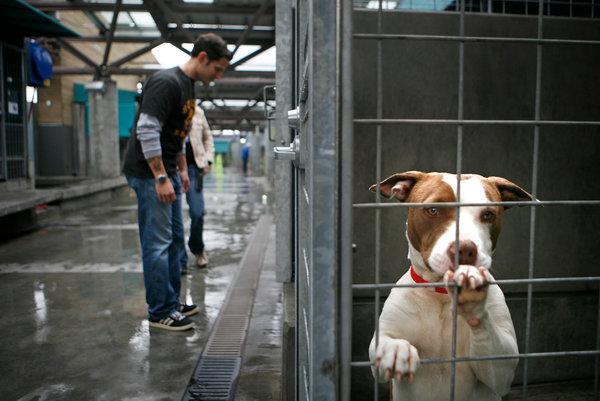
Tens of thousands of animals were spared death this weekend. A New York Times OpEd writer suggests that’s a bad thing.
A hopelessly contradictory and factually inaccurate OpEd piece in the New York Times is reigniting a false debate about whether No Kill policies help or harm animals. (Hint: saving lives rather than poisoning them to death with barbiturates, inducing a heart attack by heartsticking, or gassing them in a chamber is a good thing, a fact each and every one of us would immediately recognize if we were the ones who faced these things.)
“Are We Loving Shelter Dogs to Death?” claims that adoption is overrated and that getting animals off of death row may harm animals. Specifically, she claims that events like Clear the Shelters, in which 78,332 animals found homes and no longer face an existential death threat, are a bad idea, citing the case of a dog who was adopted at one such event and subsequently died.
In a classic case of not letting the facts get in the way of a good story, the article appeared after the L.A.P.D. reported that both the treating and forensic veterinarians did not find evidence of sexual abuse or blunt force trauma and no evidence was found that the adopter gave false information to get the dog as originally reported. (After being rightly accused of peddling false information, the author updated the article only to say that the new information which contradicted her claims “did nothing to calm tempers,” a cop-out. Unreasonable tempers are irrelevant; feelings are irrelevant; what matters are the facts and that the author is using false information to call for the potential death of tens of thousands of animals.)
She also ignores the studies which prove that “no-fee” does not mean “no-screening” and that studies have shown that events like Clear the Shelters increase the number of animals who find homes without lowering the quality of those adoptive homes. She ignores that animals are safer under even “open adoptions” than they are remaining in pounds that kill. And she ignores that you can achieve No Kill without participating in events like Clear the Shelters.
After attacking No Kill programs like adoption, the article turns around and embraces programs like high-volume sterilization and pet retention efforts by: 1. Claiming they are not part of the No Kill philosophy even though they are (in fact, they are core programs of the No Kill Equation) and 2. Pretending they are mutually exclusive even though they are not. Obviously, you can sterilize animals to reduce overall numbers, employ pet retention programs to help people keep their animal companions, and also adopt the ones in the shelter.
The problem with not doing all three is obvious: sterilization ignores the needs of the animals that are already in the shelter and under an immediate death threat, leaving them with no protection from killing of any kind. Moreover, we don’t need animals to disappear from the Earth before we can do right by them (the hundreds of cities and towns placing upwards of 99% of the animals prove it).
Her conclusion? “Adoption becomes a feel-good ‘numbers’ game, in which we carefully and proudly track only how many animals have left the shelter. No one notes how many of them end up back in the system.” Her evidence? “The head of a well-established rescue group told me that just days after a ‘clear the shelters’ event, she saw three recently adopted dogs being returned to two Los Angeles-area shelters.” That’s the long and short of it.
Three returns out of thousands of animals adopted, which is similar to what would have happened in all likelihood had they paid an adoption fee. Moreover, a dog returned to a shelter for an alternative placement has not experienced abuse. Failed adoptions merely provide another opportunity at rehoming; for such dogs, a temporary visit to a home is the equivalent of a stay in a foster home or even a boarding facility. Where is the harm? But what is worse is that it is not even true that we don’t know what happens when dogs (and cats) are adopted out during no-fee adoptions. In addition to the studies which show that no-fee adoptions do not reduce the quality of the adoptive home, some shelters do post-adoption follow-up, and other studies have done it on a national scale. We know, for example, that one in 10 dogs and cats are likely to end up back in the shelter at some point (at my last shelter, it was less than 2%).
In fact, as animals are living longer and the vast majority of people see their animal companions as “surrogate children,” senior animal companions are the fastest growing segment of the population. This and all the other data and studies about our relationship to companion dogs and cats refute the notion that most companion animals encounter cruelty from human strangers, rather than kindness or a helping hand. While abuse of animals does occur, it is not the norm. It is considered aberrant behavior which should be punished.
We also know that since Clear the Shelters targets municipal facilities, on average 40% of those 78,332 animals would have been killed: 31,333. In some communities, it is as high as 99%. They no longer will. And yes, those are numbers to feel really good about because the alternative is death, turning the title of the NYT piece literally on its Orwellian head.
Killing an animal is not an act of love. It is an act of violence. And only the most tortured and twisted illogic could possibly assert otherwise.
————-
Have a comment? Join the discussion by clicking here.